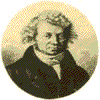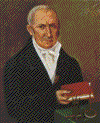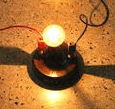In electrical circuits there are three factors that need to be considered when discussing the transfer of electrical energy within a circuit.
- Current: I - the rate at which electrons pass a point in a circuit.
- Voltage: V - the electrical energy supplied to the electrons, produced
by a battery or mains electrical supply
- Resistance: R - the degree to which electron flow is impeded or slowed down by the circuit itself.
Electric current
 This
is the rate at which electric charge passes a point in a circuit. It is
measured in Amperes or Amps, with the symbol "A" for Amps, and
is named after the Frenchman, Andre Marie Ampere (1775-1836).
This
is the rate at which electric charge passes a point in a circuit. It is
measured in Amperes or Amps, with the symbol "A" for Amps, and
is named after the Frenchman, Andre Marie Ampere (1775-1836).
Current is given the symbol I and is measured in Amps, A. For example the current in the circuit, I is 3A.
For the technically minded - when the current at a point in a circuit is 1 Amp, 1 coulomb of charge passes that point each second. This is the equivalent of 6 250 000 000 000 000 000 (six thousand two hundred and fifty million billion) electrons passing each second!.
Electrons carry the energy produced in the battery, or power station, so the more electrons which move through the circuit in a set amount of time, the more energy is carried.
Ampere was a mathematician and physicist who, with other scientists of the time, discovered the laws of electromagnetism in the early 1800s. He discovered that a magnetic field is produced when a current flows through a wire. It was because of his discoveries of the effects of electrical current that the unit was named after him.
An electric current can only flow in an electrical conductor, which includes all metals, and the nonmetal carbon. Generally speaking, other nonmetals, and gases, do not allow current to flow, and are called electrical insulators.
Voltage
 Voltage
is the amount of energy per coulomb of charge that is supplied by a battery
or power station. The unit for voltage is Volt, and the symbol is "V".
Voltage is also referred to as "potential difference". One Volt
is one joule of energy per coulomb of charge and is a measure of the energy
carried by the electrons in the circuit.
Voltage
is the amount of energy per coulomb of charge that is supplied by a battery
or power station. The unit for voltage is Volt, and the symbol is "V".
Voltage is also referred to as "potential difference". One Volt
is one joule of energy per coulomb of charge and is a measure of the energy
carried by the electrons in the circuit.
An important point to understand here is that batteries and power stations do not create electrons, but instead supply energy to the electrons which they carry through the circuit.
The word volt also comes from a person's name. He was an Italian Count called Alessandro Volta (1745-1827).
Volta invented the first battery, so his fame is recorded by his name being used for this unit. His work laid the foundation for electrochemistry, when he used the batteries he had made to decompose water into its constituent elements, hydrogen and oxygen.
The term voltage is most commonly used in relation to dry cells, car
batteries, mains electricity, and generators. They all have a potential
energy difference and supply energy to the electrons in the circuit. These
range from 1.5 volt for a single dry cell, to 12 volt for a car battery
and 240 volt for the mains supply.
Resistance
Electrons moving through the wires, on their way around the circuit, experience
resistance to flow. All common materials present some resistance to the
movement of electrons, simply because the electrons bump into the atoms
in the wires and resistors in the circuit.
Superconductors are special, very cold materials that have zero resistance. The world of superconductors is well worth investigating, but far past the scope of this topic. See the web sites for more on superconductors.

|
Why resistance? |
 Wires
are made of metals, which are good electrical conductors with a low resistance,
but resistors impede the progress of the electrons, transforming their
energy into heat. If the temperature of the resistor becomes high enough,
some of the thermal energy can be transformed into light energy. This
is how incandescent light globes work, with a high resistance glowing
wire or filament producing the light.
Wires
are made of metals, which are good electrical conductors with a low resistance,
but resistors impede the progress of the electrons, transforming their
energy into heat. If the temperature of the resistor becomes high enough,
some of the thermal energy can be transformed into light energy. This
is how incandescent light globes work, with a high resistance glowing
wire or filament producing the light.
.gif) The
unit of electrical resistance is the ohm (Ω), named after a German
scientist Georg Simon Ohm (1787-1854).
The
unit of electrical resistance is the ohm (Ω), named after a German
scientist Georg Simon Ohm (1787-1854).
The symbol (Ω) is the Greek letter omega, and is used because the letter "O" from Ohm could be confused with the number zero "0" in calculations.
| Copyright owned by the State of Victoria (Department of Education and Early Childhood Development). Used with Permission. |